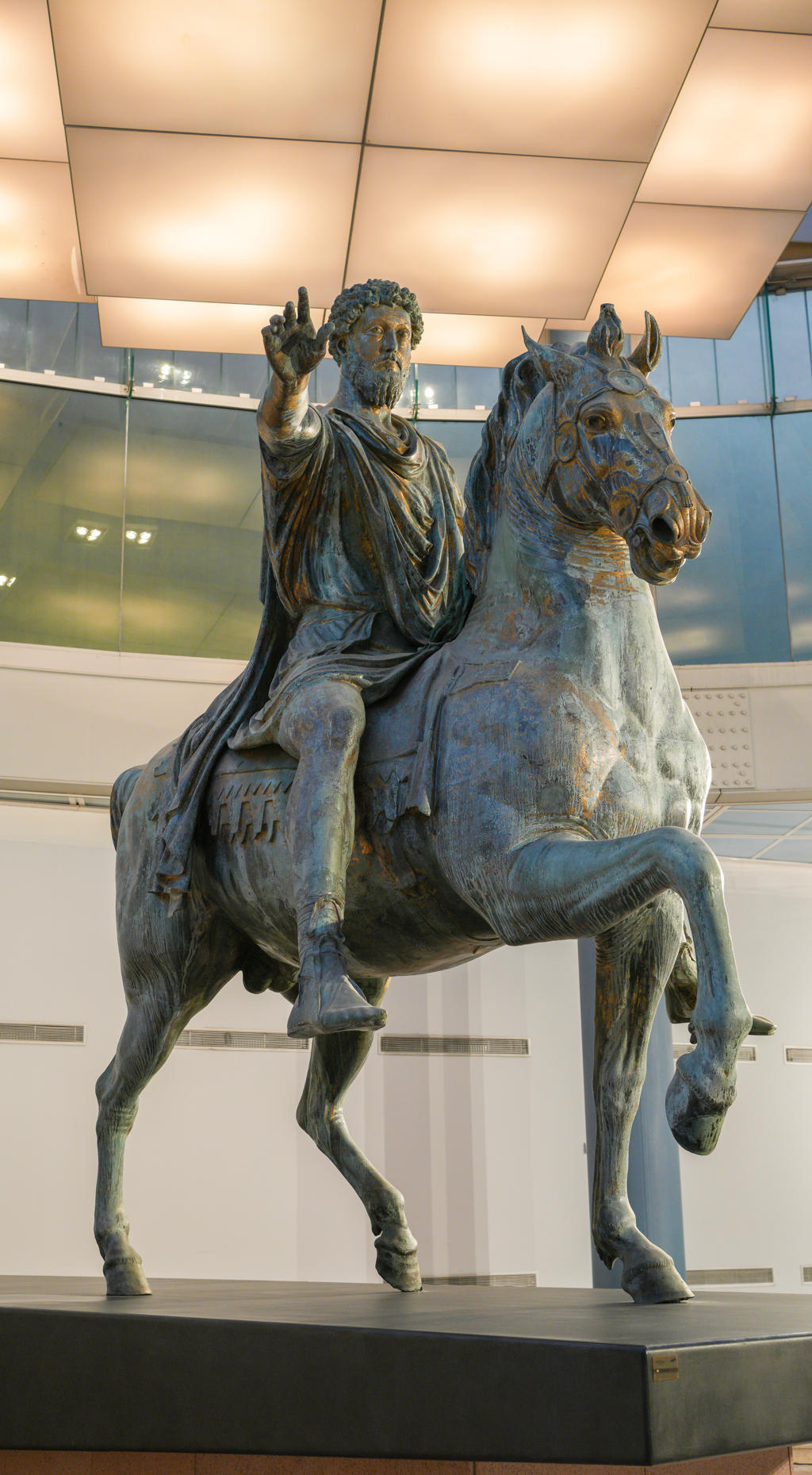About Equestrian statue of Marcus Aurelius (replica)
The equestrian statue of Marcus Aurelius, a commanding presence in the Piazza del Campidoglio, captures the essence of imperial Rome. The bronze figure, a replica of the ancient original, depicts the Roman Emperor astride a horse, his right hand raised in a gesture of clemency and authority. The horse, with its powerful stance and detailed musculature, complements the calm and composed demeanor of Marcus Aurelius, who is portrayed without armor, symbolizing his role as a philosopher-king rather than a military conqueror. This statue, one of the few surviving bronze statues of a Roman emperor, stands as a testament to the enduring legacy of Rome’s imperial past.
Originally erected in the 2nd century AD, the statue has been a symbol of Rome’s grandeur and the philosophical depth of Marcus Aurelius, known for his work "Meditations." The original statue, now housed in the Capitoline Museums to protect it from the elements, was moved to this location in the 16th century by Michelangelo, who designed the surrounding piazza. The replica now stands in its place, continuing to inspire awe and reflection among visitors who walk the historic square, a space that has been a center of Roman political life for centuries.
Life's Journey: Marcus Aurelius
Marcus Aurelius, born in 121 AD, was not only a Roman Emperor but also a Stoic philosopher. His reign, from 161 to 180 AD, is often considered the last of the Pax Romana, a period of relative peace and stability across the Roman Empire. His philosophical writings, particularly "Meditations," offer insights into his thoughts on duty, virtue, and the nature of the universe. The statue reflects his dual identity as both a ruler and a thinker, capturing the balance he sought between power and wisdom. His legacy as a philosopher-emperor continues to influence modern thought, making this statue a symbol of intellectual and moral leadership.
Plan your perfect trip to Rome with Travo! Download now and start exploring.
Living Legacy in Rome
The presence of Marcus Aurelius in the Piazza del Campidoglio serves as a reminder of Rome’s rich history and its influence on Western civilization. The statue is not just a historical artifact but a living part of the city’s cultural landscape. It draws visitors from around the world who come to admire its artistry and to reflect on the philosophical ideals it represents. The piazza itself, redesigned by Michelangelo, is a masterpiece of Renaissance architecture, harmonizing the ancient and the modern, and providing a fitting backdrop for the statue’s timeless presence.
Artistic Elements and Symbolism
The statue’s artistic elements are a testament to the skill of ancient Roman sculptors. The naturalistic portrayal of both horse and rider, with attention to detail in the flowing robes of Marcus Aurelius and the dynamic pose of the horse, exemplifies the high level of craftsmanship achieved during the period. Symbolically, the raised hand of Marcus Aurelius is interpreted as a gesture of peace and benevolence, reflecting his reputation as a just and wise ruler. The absence of military attire emphasizes his philosophical nature, setting him apart from other emperors who were often depicted in armor.
Hidden Stories in the Details
Examining the statue closely reveals subtle details that speak to its historical and cultural significance. The expression on Marcus Aurelius’s face is one of calm contemplation, a reflection of his Stoic beliefs. The horse’s posture, with one hoof slightly raised, suggests movement and vitality, symbolizing the dynamic nature of his reign. The decision to preserve the original statue indoors and display a replica outdoors highlights the importance of conservation and the desire to maintain a connection to Rome’s imperial past. The statue’s location in the Piazza del Campidoglio, a site of political and cultural importance since ancient times, reinforces its role as a symbol of Rome’s enduring legacy.
Present-Day Significance
Today, the equestrian statue of Marcus Aurelius stands as a powerful symbol of Rome’s historical and philosophical heritage. It serves as a focal point for visitors exploring the Capitoline Hill, offering a tangible link to the city’s ancient past. The statue’s presence in the piazza, surrounded by Renaissance architecture and modern life, embodies the continuity of Rome’s cultural influence. For those who visit, it is an opportunity to engage with the ideas of leadership, wisdom, and virtue that Marcus Aurelius championed, making it a timeless icon of the city’s rich and complex history.

Map loading...
Location
Piazza del Campidoglio, 00187, Rome
